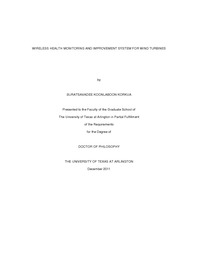| dc.description.abstract | Wind power has become the world's fastest growing renewable energy resource. The world-wide wind power installed capacity has exceeded 120 GW. The United States has set a target of 20% wind-based electricity generation, over 300 GW, by 2030. As wind power is growing towards becoming a major utility source, it is urgent to guarantee the reliable operation of wind power systems. To avoid unexpected equipment failures, the focus in most wind farm is shifting from scheduled preventive maintenance to predictive maintenance. Predictive maintenance by condition-based monitoring of electrical machines is a scientific approach that is becoming a new strategy for maintenance management. Vibration analysis is also a measurement tool used to identify, predict, and prevent failures in rotating machinery. Implementing vibration analysis will improve the reliability of the machine and lead to better machine efficiency, reducing downtime by eliminating unexpected mechanical or electrical failures. Traditionally, monitoring systems are implemented as in wired systems formed by communication cables and various types of sensors. The cost of installation and maintenance such a system is more expensive than the cost of the sensors themselves.To overcome the restrictions of wired networks, using wireless system for monitoring is proposed. A wireless sensor network is a new control network that integrates the sensors, and embedded computer, wireless communication, and intelligent processing technology. ZigBee is a new wireless networking technology with low power, low cost, and short time-delay characteristics. Compared with other similar standards such as Bluetooth, it tends to provide each single device lower complexity and cost. Based on ZigBee network communication technology, the system can deal with the various operating parameters of remote transmission, real-time data collection, and real-time health monitoring systems. Moreover, ZigBee wireless technology enables the identification of the location of each node under the network with several types of positioning algorithms.This study presents and develops a ZigBee based wireless sensor network for machine health monitoring of induction machines. The three-axis vibration signals obtained from the monitoring system are then processed and analyzed with signal processing techniques. The vibration detection techniques with suitably modified algorithms are used to extract information for an induction machine health diagnostic. The severity level of abnormality and the remaining usable life are also explored. The goal for this research is not only to monitor the machine health of wind turbine system, but also to develop a control method for doubly-fed induction generators (DFIG) that addresses the issues associated to the rotor imbalance condition of the generator. Rotor imbalance is a mechanical disturbance related problem. It is a condition where there is more weight distributed on one side of a rotating part of the rotor than on the other side. It might be caused by wind wheel unbalances, shaft imbalances, or mechanical looseness. This kind of event will directly cause oscillation on the output signal of the generator such as generated output power, current, and voltage. The proposed control method will improve the performance of the DFIG control system by reducing the oscillation of the generator output and allowing the system to operate during the slightly unbalanced condition. To suppress the vibration and minimize the oscillation of the generated output, in addition to reducing the stresses on the wind turbine, the rotor side inverter controller is designed and tested by way of a digital simulation on the Matlab/Simulink platform.The wireless health monitoring system for wind turbine based on vibration detection shows the validity and distinct advantages in such a condition based monitoring system. The severity level of rotor imbalance is successfully estimated by using machine vibration analysis. Moreover, the systematic control design of the proposed vibration suppression by means of a rotor side inverter controller is explored and discussed. The real wind speed data of four different cases from the ERCOT system were used as input to test the performance and capabilities of the control scheme. The simulation results of the generator output show the effectiveness of this proposed rotor side inverter controller. It effectively reduces the oscillation of power, current, and torque output of the DFIG wind turbine. | en_US |


